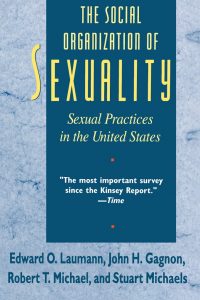
 |
| Debbie Herbenick, PhD |
In July of last year, Indiana University School of Public Health researcher Debby Herbenick and her study team published the first replication of Ed Laumann et al’s National Health and Social Life Survey (NHSLS) in nearly 25 years. Commissioned to provide a scientific basis for sexual health interventions in response to the AIDS crisis, the NHSLS was limited to asking questions about hetrosexuality, homosexuality, and those behaviors most instrumental in HIV transmission. Laumann et al, wisely focused on social networking theory in the hope that understanding who was sleeping with whom might guide policy. But the NHSLS did not inquire broadly about sexual variation. It barely made it through the Congressional appropriation process over the politics of using public money to pay researchers to ask citizens questions about their sexual behavior. Kink was simply too outrè to include and retain hope of funding.
Despite the fact that Karl Marx first used survey methods to forecast London election results in the 1840s, and the US had been regularly using surveys for a variety of purposes since the 1940’s, the NHSLS was the first and only investigation of US sexual behavior using a statistically representative sample of the US population until Herbenick’s recent work. Not that Laumann’s work accomplished much politically. Following his publishing of The Social Organization of Sexuality (1994)and Sex in America (1995) based on the NHSLS dataset, fear provoked by the AIDS crisis led the Federal Government to squander over a billion dollars on ineffective abstinence-only education which relied upon none of this research team’s insights. But that study did provide the first sound statistical basis for describing who and was having sex with whom, and what kinds they were having among the various common sexual practices that comprise the modal portion of the spectrum of sexual variability. It is the single most frequently cited work in the sociology of sex since the work of Alfred Kinsey.
Herbenick has been conducting sexuality studies on representative US samples for eight years. Most of these have looked at sexual variation issues related to heterosexual and LGBT orientation, modal sex behavior, and even and sex toy use. Spurred by the dark whispers of various insurgents and her own towering scientific curiosity, Herbenick, D, Bowling, J, Fu, T, Dodge, B, Guerra-Reyes, L and Saunders, S, in PLOS One (2017) broadened the spectrum of behaviors investigated, directly replicating Laumann’s questions about conventional practices, but inquiring substantially more broadly. Herbenick’s 2015 questionnaire published therein was not a comprehensive Noah’s Ark of every conceivable variant practice, but it did cover the rudiments of homosexual practices; multiple partner behaviors; kink, sex toy and erotica use; and inquired about internet use and mobile apps. To repeat, this study provides the first inquiry ever about such an assortment of practices on a representative US sample. And it provides plenty of brand new information and basis for suggestions about how those of us interested in further research on CNM, polyamory and kink might delve next for a deeper understanding of the relationship between kink, mental health concepts, and the management of social stigma. This in turn, is valuable to therapists who might treat the problems and discontents of the sexually adventurous.
Here is a very abbreviated summary of the study results. These are lifetime percentages of the listed behaviors for men and women:
|
Behavior
|
M%
|
F%
|
Behavior
|
M%
|
F%
|
|
Vaginal intercourse:
|
85
|
83
|
Gave partner oral sex:
|
83
|
82
|
|
Received oral sex:
|
85
|
85
|
Insertive anal sex:
|
46
|
–
|
|
Received anal sex:
|
09
|
37
|
Worn sexy underwear/lingerie:
|
26
|
75
|
|
Partnered sex in a public place:
|
45
|
43
|
Tied up partner, or been tied up:
|
26
|
22
|
|
Playfully whipped or been whipped:
|
16
|
14
|
Spanked or been spanked:
|
30
|
34
|
|
Used vibrator/dildo:
|
33
|
50
|
Used an anal sex toy:
|
18
|
16
|
|
Sex enhancement pills/herbal supps:
|
21
|
08
|
Read erotic stories:
|
57
|
57
|
|
Sex guide or sex self-help book:
|
32
|
34
|
Used a phone app related to sex:
|
12
|
06
|
|
Looked at a sexually explicit magazine:
|
79
|
54
|
Sexually explicit video/‘porn’:
|
82
|
60
|
|
Sex over Facetime/Skype:
|
14
|
11
|
Nude or semi-nude photo of self:
|
24
|
27
|
|
Received nude or semi-nude photo:
|
41
|
27
|
Flirted with someone in chat/SMS:
|
40
|
36
|
|
Gone to a strip club:
|
59
|
30
|
Taken a class/workshop about sex:
|
04
|
04
|
|
Had a threesome:
|
18
|
10
|
Had group sex:
|
12
|
06
|
|
Gone to a sex party or swingers party:
|
06
|
05
|
Gone to a BDSM club or dungeon:
|
04
|
03
|
In addition to these gender differences, the Herbenick team tabulated data about age cohorts, and how many people had done the behaviors in the last month and last year. They also inquired about the subjective appeal of the above behaviors, which was in all cases broader than actual participation. Of course, behavior and meaning are highly variably associated. The research team addresses this explicitly in accounting for the large number of lower frequency sexual behaviors that are conducted by less than two percent of respondents in the last month but have much higher aggregate lifetime percentages. These data focus on behavior, and appeal, but not on other attitudes or identifications so it is fair to say that these data tell us a lot about who has had sex scenes with multiple partners simultaneously but does not tell us about polyamory or consensual nonmonogamy. Although some of the signature behaviors of BDSM are asked about directly, it is not possible to estimate the overall prevalence of the main BDSM behaviors without items addressing cross dressing or fetishism. We eagerly await the team’s later report about trans, gay, lesbian and heterosexual behavioral differences in these behaviors.
 |
| Christian Joyal, PhD |
Still, much can be said about this rich data trove that comes from the brave first effort to collect systematic data on a much broader spectrum of sexual practices. The first observation is that, like Christian Joyal’s team’s research on Quebecoises, the conventional romantic behaviors remain widely the most popular. The largest proportion of respondents in both data sets find them appealing and in both data sets, appeal is broader than participation. In both data sets, a very wide bandwidth of sexual variability is common, and an even broader bandwidth is uncommon, but statistically frequent enough to be practiced by more than 5% of the population. Whatever one’s moral judgments might be, none of these behaviors were statistically aberrant. In this sense, they constitute a partial validation of Joyal’s conclusions about the Diagnostic and Statistical Manual’s paraphilia diagnoses, even though Herbenick did not attempt a direct replication: appeal and frequency of most behaviors do not justify calling any of these activities paraphilias except taking classes and workshops and attending BDSM clubs or dungeons if the definition of ‘paraphilia’ requires they be statistically anomalous.
For comparison, here’s a look at Joyal and Carpentier’s lifetime frequencies on their sample of questions based on the eight paraphilias of the DSMs.
|
Voyeurism
|
Men: 60%
|
Women: 35%
|
|
Exhibitionism
|
Men: 06%
|
Women: 03%
|
|
Fetishism
|
Men: 40%
|
Women: 48%
|
|
Frotteurism
|
Men: 34%
|
Women: 31%
|
|
Sadism
|
Men: 09%
|
Women: 05%
|
|
Masochism
|
Men: 19%
|
Women: 28%
|
|
Transvestism
|
Men: 07%
|
Women: 06%
|
|
Sex with a child
|
Men: 01%
|
Women: 00%
|
Joyal and Carpentier’s questions do not line up well with Herbenick’s. For example, the psychiatric definition of voyeurism as being aroused by viewing someone non-consensually is very different from viewing porn or receiving a sexy pic from a willing partner. Herbenick did not report questions that assessed frotteurism or cross dressing at all. Additionally, cross dressing means very different things in Gay female impersonation, heterosexually identified cross dressing, fetishistic cross dressing and humiliation play, ‘shemale’ porn, and transgender sexualities where it is not technically cross dressing at all because clothing is fully appropriate to one’s (non-traditional) gender. Sadism and masochism also track poorly to ’whipped or been whipped’ and ‘spanked or been spanked’ questions where power role is not specified. Joyal’s and Carpentier’s conclusion that 48% of Quebecois respondents endorse at least one ‘paraphilic’ behavior begs for a comparison statistic from Herbenick’s sample about how many Americans had done at least one of any BDSM or multiple sex partner activity lifetime, last year, or last month, although this would still exclude the nonconsensual paraphilias Joyal included in his overall figure.
It takes some reading between the lines, but in many way, these figures look similar.
That said, the participation of the most popular single dimension of BDSM: spanking, runs at least 7 times the frequency of ever having attended a BDSM club or dungeon. If we recognize that not all ‘spankos’ regard themselves as kinksters and recognize the non-overlap of those who prefer whipping, role play, bondage, and the absent major categories of crossdressing and gender play, and fetishism, it is probable that participation in BDSM communities covers about 10 percent or less of people who have ever tried kinky behaviors at least once so far in their lifetimes in Herbenick’s sample. This makes those kinksters who do participate in ‘out’ community activities seem like an elite vanguard who are at risk of being systematically different from the bulk who do not socially participate. This also suggests that considerable risks attend our efforts to extrapolate what we know about kink from studies of kink samples of convenience drawn from socially ‘out’ kinksters. I note also that in S.Wright, D. Cox and R. Stambaugh’s 2014 Consent Violations Survey, 70% of our sample of convenience stated that they were not out to family, co-workers, or people with whom they lived. I am using ‘out’ here in quotes to mean out enough to participate on-line or socially in kink, a definition shared by neither Joyal’s team nor Herbenick’s.
These results do not inquire directly about the important phenomenon of on-line sexual communities. But they do provide some basis for reassuring us against panic stemming from spreading technology use. If negative health or psychological effects attend technology use, surely the low rates of use of phone apps, for example, preclude epidemics related to their use. Men and women have strikingly similar rates of picture sharing on-line. This does not prove that they are sent and received consensually, or such behavior is satisfying, but the appeal rates of these behaviors suggest that many find the fantasy appealing in prospect despite media-documented risks and problems.
©Russell J Stambaugh, PhD, Ann Arbor, August 2018
